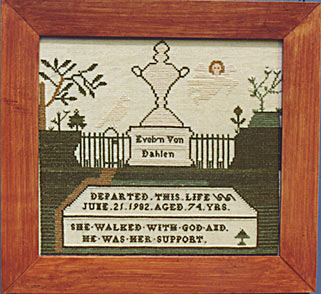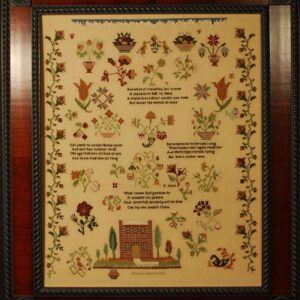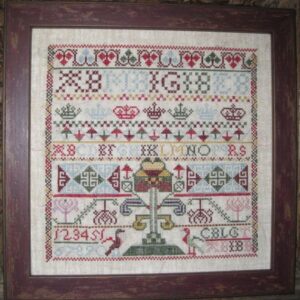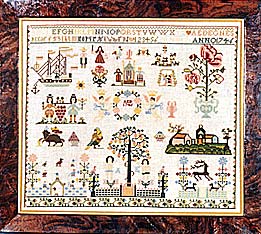Mourning Sampler 1832
From: $7.00
Origin and date: English and American, late 18th and early 19th centuries
Rated: Beginning
Linen count and finished size: 30 count, hand-dyed 8-1/2″x9″
Stitches: Cross, straight and satin
Source: Private collection
Description
Mourning pictures were not an uncommon art form in England and America in the late 18th and early 19th centuries . Evolving from European commemorative art honoring deceased heroes, mourning pictures were an acceptable and cherished way to remember loved ones, designed to hang in the most important public rooms of the house. Considered neither morbid nor overly sentimental, they in fact reflected the religious, social and aesthetic ideals of the period.
Discoveries at Pompeii and Herculaneum in the early 18th century, the pervasiveness of ancient history (Green and Roman) and heroic death in education, contributed to the development of important symbolism. Creating a work of mourning art was not simply a schoolgirl’s art exercise. Apart from cultivating and demonstrating a talent for needlework, design and oftentimes painting, it reinforced literary, religious and historic lessons by incorporating into the mourning scene symbols such as the urn (the repository of earthly remains, and spirit); the lush garden reminiscent of Eden and resurrection; the triangular composition (usually urn, tree, mourner, but this varied); and the mourning figure, a form taken directly from ancient Greek and Roman art. Different plants in the gardens symbolize different concepts: e.g. the bushy or fallen oak or elm stand for strength and dignity; the willow is an ancient symbol of mourning and in Christian theology a symbol of resurrection because it grows beside the water and can regenerate after being cut; the evergreen represents life-in-death, and it points upward; columbines symbolize the presence of the Holy Spirit; the thistle is earthly sorrow and sin; and the lowly forest fern is humility. Each mourning picture, depending upon the elements within it, becomes a poem unto itself with its own specific symbolism.
This simple mourning sampler, probably worked in England, was made in 1832 upon the death of Wilmot Headen. While it is vastly simpler than the elaborate mourning pictures made by girls at better schools, in higher ranks of society, it exemplifies an distills the symbolic elements common to this art form: the urn, the plinth, the tree, the garden, the memorial verse. Reproduced exactly to the scale of the original, only the name and date have been left blank, for you to fill in the name of your loved one. Instructions and alphabets for personalizing the piece are included. Making use of cross, straight and satin stitches on hand-dyed 30-count linen, it is recommended for beginning to intermediate level needleworkers. The finished size is approximately 8-1/2″x9″.
Additional information
| Format Options |
|---|






